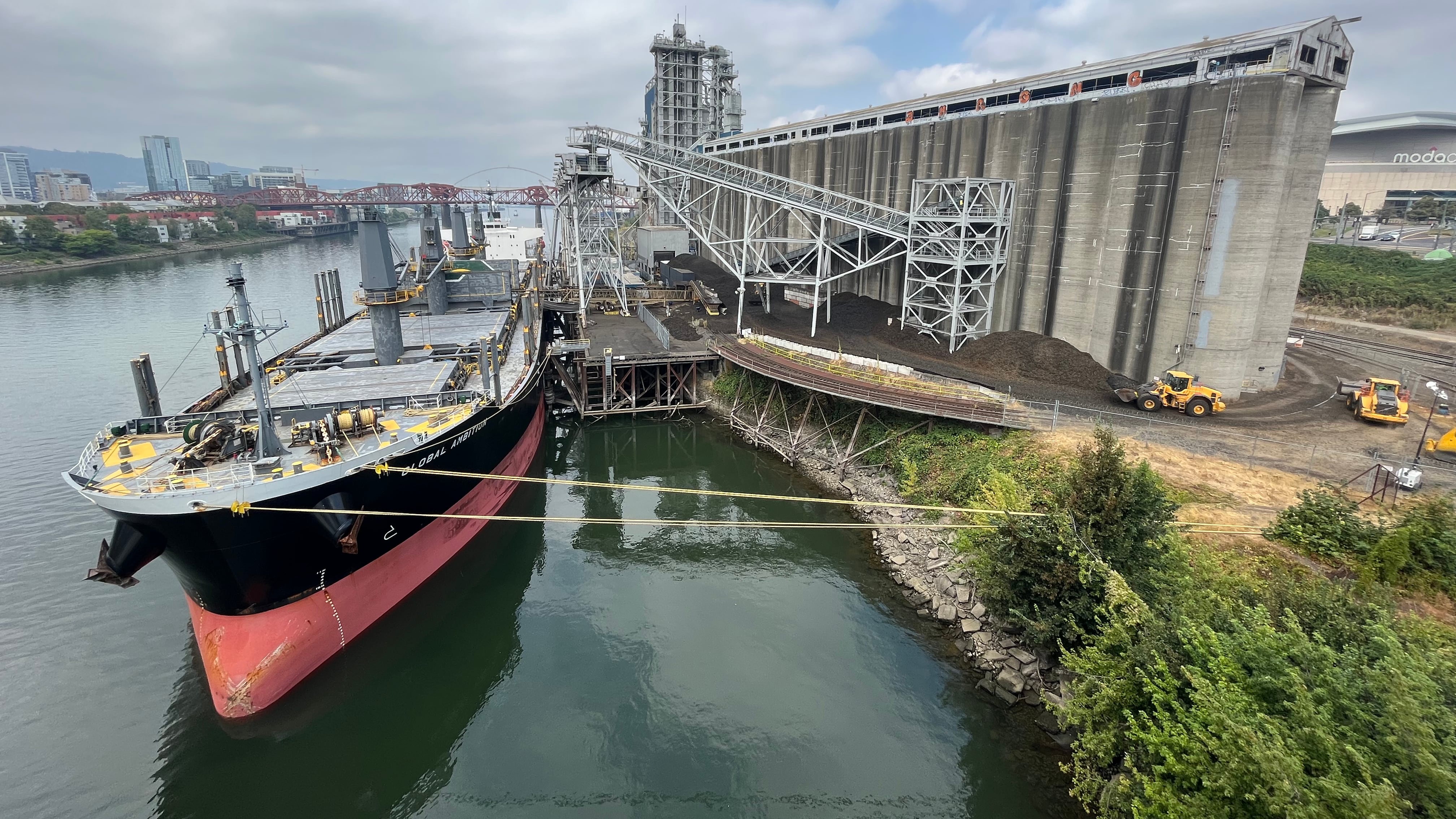The second cargo ship in two months arrived Sunday at the old Louis Dreyfus grain terminal next to the Steel Bridge and took on a load of shredded tires from Castle Tire Recycling, a Portland company that uses the site on the Willamette River to export the tire shards to Asia, where they are often burned for fuel.
The Global Ambition, a 600-foot bulk carrier arrived at the dock Sept. 11, according to vesselfinder.com. This week, three front loaders buzzed around the grain silos, scooping up tire shards and loading them onto a conveyor belt that led into the belly of the ship. A dust cloud kicked up each time a loader dropped a bucketful into the bin that led to the conveyor.
Travis Williams, executive director of the environmental watchdog Willamette Riverkeeper, observed the process from the Steel Bridge and filmed what appeared to be tire chips falling from the conveyor belt into the river, making ripples. The terminal’s operators stretched a tarp under the conveyor, but some of the tire shards appeared to fall past it.
“My guess is that if we were to look at the river bottom right here, there’d be some nice piles of shredded tires,” Williams says. “This is the kind of thing that is ridiculous in the year 2022.”
The grain terminal is owned by an entity called Castle Arden LLC, which, in turn, is owned by Beau Blixseth, the son of Tim Blixseth, one of Oregon’s most famed timber barons, and a shredded-tire magnate named Chandos Mahon, who is also head of Castle Tire Recycling.
“We take these accusations very seriously,” Mahon said in an email. The loading is “contracted and managed by a reputable 3rd-party service provider that bulk loads commodities into vessels at multiple terminals up and down the Willamette and Columbia River. Environmental protection and safety are top priorities when loading.”
Presented with photos of the operation that showed ripples from falling debris, Mahon wrote: “It looks like the ripple is at the front of the vessel where the vessel is tied to the front dock dolphin. The vessel is not loaded at the front, it is loaded at the middle. Additionally, water ripples can also be caused by marine life, birds, tree branches, tree logs, and objects already in the water that hit the vessel or disturb the water. If you zoom really close into the photo, there’s a lot Willamette River trash in that exact ripple spot. Trash comes from up river.”
Williams says Willamette Riverkeeper plans to report the errant tire shards to the Oregon Department of Environmental Quality. In July, DEQ spokeswoman Susan Mills said Tire Disposal & Recycling, an affiliate of Castle Tire with the same address, operates under a DEQ “waste tire storage and carrier permit” at its facility on Harborgate Street, just west of Bybee Lake, far up in North Portland, where it shreds the tires.alling from the conveyor.”
Williams says the Willamette Riverkeeper plans to report the errant tire shards to the Oregon Department of Environmental Quality. In July, DEQ spokeswoman Susan Mills said Tire Disposal & Recycling, an affiliate of Castle Tire with the same address, operates under a DEQ “waste tire storage and carrier permit” at its facility on Harborgate Street, just west of Bybee Lake, far up in North Portland, where it shreds the tires.
“Once processed, DEQ considers the shredded tires to be ‘product,’” Mills said in an email. “Since product moves (is transported/sold), it does not require a waste permit, so one is not required at the grain elevator site.”
DEQ inspectors visited the elevator Aug. 4, unannounced, and found no violations, according to DEQ.
“They observed two piles of tire shred product stored on the east and west sides of the grain silo building on the property,” Lauren Wirtis, another DEQ spokeswoman, said. “No tire shreds were visible outside of the two piles. DEQ inspectors did not observe any visible dust or odor during their visit.”
The DEQ team visited the site after the first cargo ship, the Petra, had left, and the front loaders had stopped operating.
Contrary to what DEQ found Aug. 4, tire shards like the ones piled up at the terminal are visible along North Interstate Avenue, from Thunderbird Way, the short street that leads to the terminal, to Broadway.
